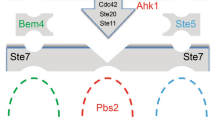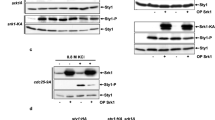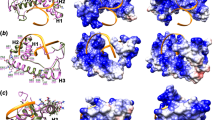Abstract
Mitogen-activated protein kinase (MAPK) cascades are conserved signalling modules that regulate responses to diverse extracellular stimuli, developmental cues and environmental stresses (reviewed in refs 1,2,3). A MAPK is phosphorylated and activated by a MAPK kinase (MAPKK), which is activated by an upstream protein kinase, such as Raf, Mos or a MAPKK kinase. Ste7, a MAPKK in the yeast Saccharomyces cerevisiae, is required for two developmental pathways: mating4 and invasive (filamentous) growth5,6. Kss1 and Fus3, the MAPK targets of Ste7, are required for mating7,8, but their role in invasive growth has been unclear. Because no other S. cerevisiae MAPK has been shown to function in invasive growth, it was proposed5,6,9 that Ste7 may have non-MAPK targets. We show instead that Kss1 is the principal target of Ste7 in the invasive-growth response in both haploids and diploids. We demonstrate further that Kss1 in its inactive form is a potent negative regulator of invasive growth. Ste7 acts to relieve this negative regulation by switching Kss1 from an inhibitor to an activator. These results indicate that this MAPK has a physiologically important function in its unactivated state. Comparison of normal and MAPK-deficient cells indicates that nitrogen starvation and activated Ras stimulate filamentous growth through both MAPK-independent and MAPK-dependent means.
This is a preview of subscription content, access via your institution
Access options
Subscribe to this journal
Receive 51 print issues and online access
$199.00 per year
only $3.90 per issue
Buy this article
- Purchase on Springer Link
- Instant access to full article PDF
Prices may be subject to local taxes which are calculated during checkout





Similar content being viewed by others
References
Bardwell, L., Cook, J. G., Inouye, C. J. & Thorner, J. Signal propagation and regulation in the mating pheromone response pathway of the yeast Saccharomyces cerevisiae. Dev. Biol. 166, 363–379 (1994).
Cobb, M. H. & Goldsmith, E. J. How MAP kinases are regulated J. Biol. Chem. 270, 14843–14846 (1995).
Denhardt, D. T. Signal-transducing protein phosphorylation cascades mediated by Ras/Rho proteins in the mammalian cell — the potential for multiplex signaling. Biochem. J. 318, 729–747 (1996).
Zhou, Z., Gartner, A., Cade, R., Ammerer, G. & Errede, B. Pheromone-induced signal transduction in Saccharomyces cerevisiae requires the sequential function of three protein kinases. Mol. Cell. Biol. 13, 2069–2080 (1993).
Roberts, R. L. & Fink, G. R. Elements of a single MAP kinase cascade in Saccharomyces cerevisiae mediate two developmental programs in the same cell type: mating and invasive growth. Genes Dev. 8, 2974–2985 (1994).
Liu, H., Styles, C. A. & Fink, G. R. Elements of the yeast pheromone response pathway required for filamentous growth of diploids. Science 262, 1741–1744 (1993).
Elion, E. A., Brill, J. A. & Fink, G. R. FUS3 represses CLN1 and CLN2 and in concert with KSS1 promotes signal transduction. Proc. Natl Acad. Sci. USA 88, 9392–9396 (1991).
Ma, D., Cook, J. G. & Thorner, J. Phosphorylation and localization of Kss1, a MAP kinase of the Saccharomyces cerevisiae pheromone response pathway. Mol. Biol. Cell 6, 889–909 (1995).
Hunter, T. & Plowman, G. D. The protein kinases of budding yeast: six score and more. Trends Biochem. Sci. 22, 18–22 (1997).
Gimeno, C. J., Ljungdahl, P. O., Styles, C. A. & Fink, G. R. Unipolar cell divisions in the yeast S. cerevisiae lead to filamentous growth: regulation by starvation and RAS. Cell 68, 1077–1090 (1992).
Gavrias, V., Andrianopoulos, A., Gimeno,, J. & Timberlake, W. E. Saccharomyces cerevisiae TEC1 is required for pseudohyphal growth. Mol. Microbiol. 19, 1255–1263 (1996).
Mösch, H. U., Roberts, R. L. & Fink, G. R. Ras2 signals via the Cdc42/Ste20/mitogen-activated protein kinase module to induce filamentous growth in Saccharomyces cerevisiae. Proc. Natl Acad. Sci. USA 93, 5352–5356 (1996).
Madhani, H. D. & Fink, G. R. Combinatorial control required for the specificity of yeast MAPK signaling. Science 275, 1314–1317 (1997).
Neiman, A. M. & Herskowitz, I. Reconstitution of a yeast protein kinase cascade in vitro : activation of yeast MEK homologue STE7 by STE11. Proc. Natl Acad. Sci. USA 91, 3398–3402 (1994).
Courchesne, W. E., Kunisawa, R. & Thorner, J. Aputative protein kinase overcomes pheromone-induced arrest of cell cycling in S. cerevisiae. Cell 58, 1107–1119 (1989).
Cook, J. G., Bardwell, L., Kron, S. J. & Thorner, J. Two novel targets of the MAP kinase Kss1 are negative regulators of invasive growth in the yeast Saccharomyces cerevisiae. Genes Dev. 10, 2831–2848 (1996).
Tedford, K., Kim, S., Sa, D., Stevens, K. & Tyers, M. Regulation of the mating pheromone and invasive growth responses in yeast by two MAP kinase substrates. Curr. Biol. 7, 228–238 (1997).
Sherman, F., Fink, G. R. & Hicks, J. B. Methods in Yeast Genetics (Cold Spring Harbor Laboratory Press, Cold Spring Harbor, New York, 1986).
Lorenz, M. C.. Gene disruption with PCR products in Saccharomyces cerevisiae. Gene 158, 113–117 (1995).
Bardwell, L., Cook, J. G., Chang, E. C., Cairns, B. R. & Thorner, J. Signaling in the yeast pheromone response pathway: specific and high-affinity interaction of the mitogen-activated protein (MAP) kinases Kss1 and Fus3 with the upstream MAP kinase kinase Ste7. Mol. Cell. Biol. 16, 3637–3650 (1996).
Herskowitz, I. & Jensen, R. E. Putting the HO gene to work: practical uses for mating-type switching. Meth. Enzymol. 194, 132–146 (1991).
Gietz, R. D. & Sugino, A. New yeast-Escherichia coli shuttle vectors constructed with in vitro mutagenized yeast genes lacking six-base pair restriction sites. Gene 74, 527–534 (1988).
Guarante, L. & Ptashne, M. Fusion of Escherichia coli lacZ to the cytochrome c gene of Saccharomyces cerevisiae. Proc. Natl Acad. Sci. USA 78, 2199–2203 (1981).
Sprague, G. F. J Assay of yeast mating reaction. Meth. Enzymol. 194, 77–93 (1991).
Acknowledgements
We thank D. Voora for technical assistance with the data shown in Fig. 1e, and G. R. Fink for reagents. This work was supported by an NIH–NIGMS predoctoral traineeship and an NIH-NCI postdoctoral traineeship (to J.G.C.), an NIH-NCI postdoctoral traineeship and a senior postdoctoral fellowship from the Leukemia Society of America (to L.B.), an NIH-NIGMS research grant (to J.T.) and resources provided by the Berkeley campus Cancer Research Laboratory.
Author information
Authors and Affiliations
Corresponding author
Rights and permissions
About this article
Cite this article
Cook, J., Bardwell, L. & Thorner, J. Inhibitory and activating functions for MAPK Kss1 in the S. cerevisiae filamentous- growth signalling pathway. Nature 390, 85–88 (1997). https://doi.org/10.1038/36355
Received:
Accepted:
Issue Date:
DOI: https://doi.org/10.1038/36355
This article is cited by
-
Genome-wide evolution of MAPKs family and their expression in response to bacterial infection in seahorse Hippocampus erectus
Journal of Oceanology and Limnology (2021)
-
A Rab escort protein regulates the MAPK pathway that controls filamentous growth in yeast
Scientific Reports (2020)
-
New molecular insights on the response of the green alga Tetraselmis suecica to nitrogen starvation
Scientific Reports (2019)
-
Messengers for morphogenesis: inositol polyphosphate signaling and yeast pseudohyphal growth
Current Genetics (2019)
-
Nuclear relocation of Kss1 contributes to the specificity of the mating response
Scientific Reports (2017)
Comments
By submitting a comment you agree to abide by our Terms and Community Guidelines. If you find something abusive or that does not comply with our terms or guidelines please flag it as inappropriate.



